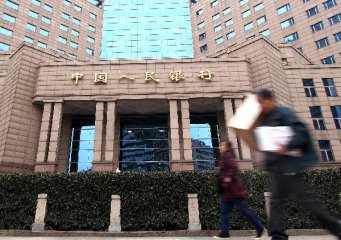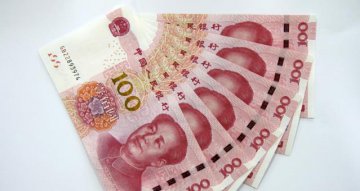
The People’s Bank of China (PBOC) resumed reverse repurchase in the open market on September 12. Analysts believe that although liquidity is subject to multiple factors in September, the PBOC’s action is signaling a start of injection, and there is no need to worry about liquidity in the month. The more important concern in September is whether the interest rate in the open market will change at the end of the month. Market opinions are mixed. However, the market remains unanimous that the monetary policy will not tighten sharply.
Why reverse repo suspends, and resumes
Liquidity expectations have been undergoing subtle changes since late August as the PBOC suspended reverse repo, and replaced mature medium-term lending facilities (MLF) with same amounts of new ones, and is said to conduct repurchase.
Analysts believe that the cross-validation of the PBOC’s action, announcements, and market interest rates indicates that its goal of maintaining a reasonable liquidity has not changed. Based on this goal, the PBOC has not changed much on its bi-directional adjustment of liquidity. Although there are many disturbance factors in liquidity supply and demand in September, it is of high probability that the liquidity remains properly tight.
In the current period, the PBOC aims to “maintain ample and reasonable liquidity”. Whether liquidity deviates from “ample and reasonable” is the key driver of the open market operations.
The PBOC suspended reverse repo for 15 consecutive working days from August 22 to September 11. Although it injected blood into the market twice in the period, it still withdrew a net of 150 billion yuan from the market given a large amount of reverse repo and MLF coming due. But this does not mean that the central bank's liquidity goal or the monetary policy orientation has changed, and it must be considered in conjunction with the liquidity situation.
From the perspective of money market interest rate, from the end of August to the beginning of September, the 7-day repo rate in the interbank market remained at 2.6 percent, and fell below 2.5 percent at the beginning of September, and even hit to the bottom of 2.39 percent. The market basically believes that 2.55 percent-2.75 percent level is in a “preferential range”, which corresponds to the state of “ample and reasonable” liquidity. In the past few weeks, liquidity has deviated somewhat from the “ample and reasonable.
Since liquidity is at or beyond reasonable abundance, there is no need to continue to inject more liquidity. If necessary, it should also withdraw liquidity to keep it at an ample and reasonable level. This is why the central bank has remained silent in the past few weeks.
In mid-September, as the liquidity of the money market has converged, the PBOC restarted reverse repo to inject funds into the market. This further confirms that its goal of maintaining a reasonable liquidity has not changed. The PBOC pimped 60 billion yuan into the market via 7-day reverse repo on August 12. This is the first reverse repo since August 22.
Facing four influential factors
As the last month of the third quarter, September faces many factors influencing liquidity and particularly affecting supply and demand of liquidity in the middle and the end of the month. Therefore, it cannot be said there’s no challenge for liquidity of monetary market within the month. However, based on above analysis, as long as the central bank’s target of regulating liquidity doesn’t change, liquidity won’t continue to deviate a lot from reasonable affluent situation.
Based on analysis of institutions, there’re four factors influencing supply and demand of liquidity in the middle and late September.
Firstly, payment for subscription of government bonds. Local government bonds see peak issuance in September. In addition, supply of national bonds and governments will be offered in a period. Payment for buying government bonds is a process of capitals flowing from banking systems to the central bank, causing withdrawal of liquidity.
Secondly, tax payment of enterprises in mid-September. Although September traditionally sees net fiscal input, tax still exerts influence in the middle of the month. Particularly, corporate tax payment and payment for buying government bonds may see peak in the middle of September, together pushing up fiscal revenues and liquidity withdrawal.
Thirdly, supervision assessment at the end of the third quarter. Given the strengthening supervision policy, assessment over financial supervision at the end of the quarter may exert slighter influence than that in 2018, but it cannot be neglected.
Fourthly, cash injection before long vacation. There’s short period between the Mid-Autumn Day and the National Day holidays, there’s increasing demand for banks to inject cash to the market before the holidays, which will affect banking liquidity to some extent.
On the whole, there are many factors influencing supply and demand of liquidity in September, and particularly in the middle and late September. But on the other hand, it would become a period when the central bank conduct reverse regulation on liquidity.
The central bank usually injects liquidity in the middle of a month and withdraws capitals at the end and the beginning of a month based on the situation of financial revenues and expenditure. Many industry insiders view that the reverse repo by the central bank on September 12 probably means the beginning of liquidity injection, which may be followed by more open market operations (OMOs) so as to keep liquidity at a reasonable affluent level. It is unnecessary to worry much about liquidity within this month.
Doubt and consensus about OMO
The biggest highlight in monetary market in September is interest rate in the open market operation. The US Federal Reserve will have a conference to discuss the interest rate in late September. It is basically believed that the Fed will raise interest rate at this conference. What is not sure is whether interest rate at China’s OMO will follow the Fed to pick up. Research institutions are unable to give an answer.
With thought of stabilizing exchange rate, monetary policies of China and the US are expected to see linkage again this month and the central bank is largely probably to raise OMO interest rate by 5 basis points, according to research team of Citic Securities. Huachuang Securities also said that China’s OMO interest rate may follow the Fed to rise by that time.
BOCI Securities pointed out that the previous rise in OMO interest rate happened in the situation where market interest rate was much higher than policy rate. But at present, there’s few difference between the two interest rates. It means different a lot if raising OMO interest rate significantly at this moment. Therefore, there’s bigger chance that interest rate will not be raised.
Guosheng Securities stressed that it may not be a signal of tightening policy despite rise in policy rate in September. If the central bank raise OMO interest rate, it is likely to be loose, according to Citic Securities. Hence, there’s common consensus that monetary policy won’t be tightened remarkably.
Translated by Coral Zhong & Vanessa Chen






















Latest comments